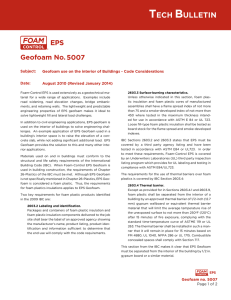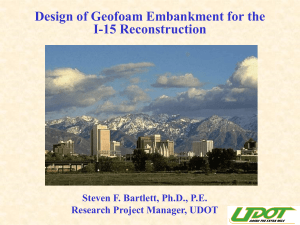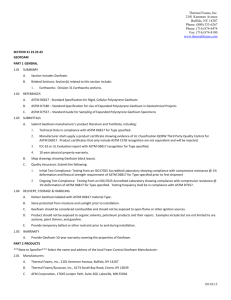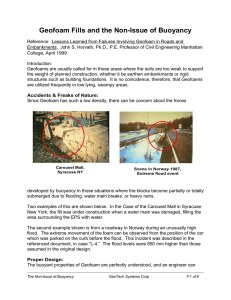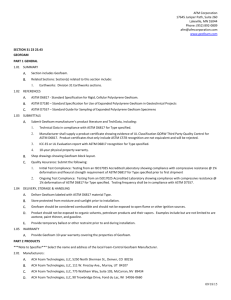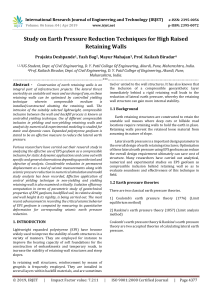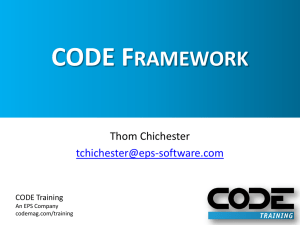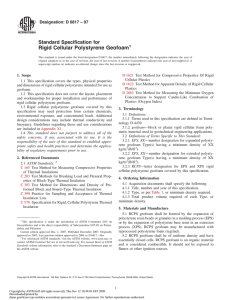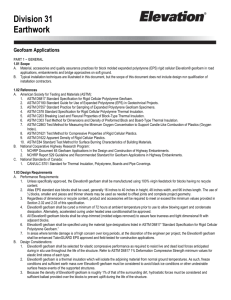Expanded Polystyrene (EPS) Geofoam Applications & Technical Data
advertisement
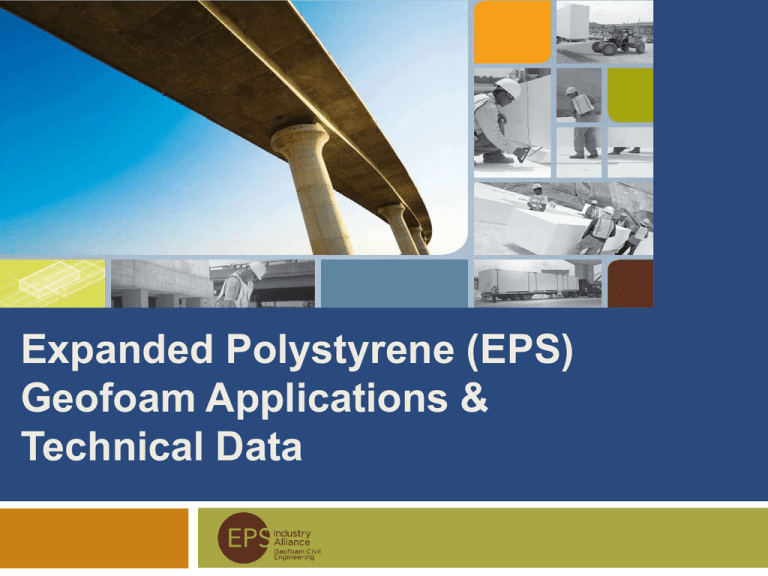
Expanded Polystyrene (EPS) Geofoam Applications & Technical Data EPS Geofoam Expanded polystyrene (EPS) geofoam used as geotechnical material since the 1960s. Solves engineering challenges. Lightweight. Approximately 1% the weight of soil. Less than 10% weight of other lightweight fill alternatives. Reduces loads imposed on adjacent and underlying soil & structures. EPS Geofoam Benefits Accelerates project schedules. Easy to handle. Unaffected by weather conditions. Can be cut & shaped onsite. Retains physical properties under engineered condition of use. Arrives onsite having undergone rigorous QA/QC testing. EPS Geofoam Applications & Use Road construction over poor soils Road widening Bridge abutment Bridge underfill Culverts, pipes & buried structures Compensating foundation Rail embankment Landscaping & vegetative green roofs Retaining & buried wall backfill Slope stabilization Stadium & theatre seating Levees Airport runway/taxiway Foundations for lightweight structures Noise & vibration damping Compressible application Seismic application Permafrost embankments Rockfall/impact protection ASTM EPS Geofoam Standards EPS geofoam is available in different material types. Thorough knowledge & understanding of the material type being used on an EPS geofoam project is essential. ASTM D6817 Standard Specification for Rigid Cellular Polystyrene Geofoam Physical properties & dimensions of EPS geofoam. ASTM D7180 Standard Guide for the Use of EPS Geofoam in Geotechnical Projects Design considerations for EPS geofoam. ASTM D7557 Standard Practice for Sampling of EPS Geofoam Specimens Quality assurance. EPS geofoam specification EPS geofoam applications Road construction over poor soils Replaces compressible, soft soils or heavy fill materials. Prevents unacceptable loading on underlying soils and adjacent structures. High compressive strength supports interstate traffic loadings. Road widening Eliminates need for compaction & fill testing. Minimizes impact to existing roadway, adjacent structures & buried utilities. Withstands traffic forces. Reduces construction time. Bridge abutment Safely supports highway loading without overstressing underlying soils. Less differential movement at bridge/approach. Reduces cost of approach slab. Reduces long term maintenance. Reduces lateral forces on abutment walls, foundations & other retaining structures. Savings in design of bridge abutment & other walls. Bridge underfill Adds minimal load to underlying ground. Helps support bridge span & transfer traffic load safely to foundation or underlying soil. Culverts, pipelines & buried structures Used in lieu of heavier traditional fills over structures that were not designed to support increased loads. Eliminates the need for removal or strengthening of existing underground structures. Compensating foundation Reduces load on underlying compressible soils. Minimizes building settlement & potential bearing capacity problems. Rail embankment Strong enough to support railway loads. Does not overload existing soils. Prevents settlement of adjacent structures & utilities. Landscaping & vegetative green roofs Vegetative roof benefits. Reduce rainwater runoff. Improve air quality. Reduce air temperatures. Can be cut/trimmed onsite to fit odd geometries. Installed without special equipment. Does not add any appreciable load to roof structure. Provides insulation value. Retaining & buried wall backfill Reduces lateral pressures on structure. Limits horizontal forces that can develop during earthquakes. Slope stabilization Stabilizes & repairs soil & rock slopes. Replaces portion of existing soil. Entire mass slide may not need to be excavated & replaced. Significant time & cost savings. Stadium & theatre seating Tiered seating for auditoriums, movie theatres, gymnasiums & churches. New construction & renovation projects. Levees Provides volume need to return levee to original configuration. Reduces/eliminates additional stress & cycle of settlement & levee raising. Airport runway/taxiway Replaces unsuitable soils without overloading underlying subgrade materials. Controls settlement on highly compressible & saturated soils. Prevents differential settlements at intersection of new & existing pavements. Foundations for lightweight structures Replaces traditional agricultural pile footings on peat soils. Little to no settlement of footings. Advantages Lightweight Cost savings Ease of construction Transportability for re-use. Special applications Noise & vibration dampening Compressible application Reduces seismic forces imposed on buried structures, retaining walls, pipelines, etc. Permafrost embankments Designed for strains beyond 1%. Seismic application Free-standing walls or embankments to reduce highway noise. Reduce transmission of ground borne vibrations under railways or pavements. Insulates underlying permafrost & reduces thawing & thaw-consolidation of ice-rich permafrost soils. Rockfall/impact protection Improves performance of protection galleries due to high energy absorption. EPS geofoam design considerations Design considerations Lightweight Manufactured in unit weights ranging from 0.7 – 2.85 lbs/cu3/ft. Imparts small dead load or stress to underlying soils, structures & utilities. Eliminates need for specialized foundations or site preloading to reduce settlement & improve bearing capacity. Reduces lateral stresses behind earth retaining structures. Design considerations EPS geofoam design loads are recommended to not exceed the compressive resistance at 1% capacity. This limit controls the amount of long-term deflection, or creep, resulting from permanent sustained loads. Strength Available in a wide range of compressive resistances. Different types of EPS geofoam can be specified on a single project to maximize savings. Ease of handling Handled onsite by laborers or mechanized equipment. Field cut using hot-wire cutter, hand saw or chain saw. Design considerations Construction time Construction cost Faster placement rates, reduced utility relocation & less traffic disruption. Not affected by adverse weather conditions. Adjacent structures can be designed to be less robust/expensive. Lower installation & maintenance costs. Stability Permanent material when correctly specified & installed. Design considerations Insulation Superior, long-term thermal insulation. Protection Can be damaged when exposed to certain hydrocarbons. Hydrocarbon resistant geomembranes. Manufactured with flame retardant. Long-term UV exposure is generally surficial & does not cause detrimental property changes. High wind speeds should be monitored; sandbags can be placed on top of EPS geofoam to prevent blocks from shifting. Design considerations Buoyancy Water absorption Adequate surcharge or passive restraint must be provided against uplift. Closed cell structure of EPS limits water absorption. Sustainability Can be reground, recycled and reused in composite applications (lightweight concrete, plastic lumber, etc.) Reduced transportation & fuel costs. State-of-the-art manufacturing. EPS geofoam technical data EPS geofoam specification Technical data Compressive resistance Design recommendation: limit loading to the compressive resistance at 1% strain. Stress at compressive strain of 1% = elastic limit stress. Technical data Technical data Creep Load distribution Poisson’s ratio ~ 0.12 within the elastic range. Coefficient of friction Minimal at strain levels below 1%. µ = 0.5 R-value ASTM C578 Standard Specification for Rigid Cellular Polystyrene Thermal Insulation. Technical data Water absorption Closed cell structure of EPS limits water absorption. If installed in a submerged application, an increase in density will occur over time. Stability Resistant to fungi & mold. No nutritional value to insects. Technical data Contacts & resources EPS Industry Alliance 1298 Cronson Blvd., Suite 201 Crofton MD 21114 800-607-3772 info@epscentral.org www.epsmolders.org ASTM International 100 Barr Harbor Drive West Conshohocken, PA 19428-2959 www.astm.org U.S. Department of Transportation Federal Highway Administration 1200 New Jersey Ave. SE Washington, DC 20590 202-366-4000 www.fhwa.dot.gov Geofoam Research Center College of Engineering & Computer Science 237 Hinds Hall Syracuse University Syracuse, NY 13244-1240 grc@syr.edu geofoam.syr.edu National Cooperative Highway Research Program (NCHRP) Transportation Research Board The National Academies 500 Fifth St. NW Washington, DC 20001 202-334-2934 www.trb.org/NCHRP/Public/NCHRP.aspx
